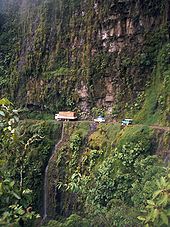Yungas
The Bolivian Yungas is a region of two elongate troughs running parallel to the east edge of the Cordillera Real run and the transition between the highlands of the Andes (about 4000 m above sea level.. ) And the tropical lowland with the Amazon - rainforest (ca. 500 m). The region lies in the La Paz Department and is politically divided into the provinces of Nor Yungas (North Yungas) and Sud Yungas (South Yungas).
In a broader sense, the areas adjacent to the south and north of the same altitude level are also called Yungas , see also Yunga .
At altitudes between 1200 m and 1800 m, coffee , fruit , citrus fruits and, in large areas, coca bushes thrive due to the mild climate . The agricultural products of the Yungas are important for the supply of La Paz .
The Yungas are supplied with moisture from the lowlands by the trade winds for most of the year . The winters (July) are always drier than the summer (January). The amount of precipitation increases with altitude and from around 3000 m there is often permanent fog.
The largest town in the Yungas is Coroico with around 4,000 inhabitants at an altitude of 1,750 m. It is the administrative center of Nor Yungas Province.
On the drive from La Paz on the Yungas Strait over the La Cumbre Pass (4,650 m) to Coroico, an altitude difference of around 63 kilometers is overcome, from snow and ice at the level of the pass to the tropical rainforest crosses almost all climatic and ecological zones of South America in the valley. The old connection between La Paz and Coroico is called the Death Road (Spanish: carretera de la muerte ), mainly because of the enormous difference in altitude between valley and mountain and especially because of the many traffic fatalities that accidents on this road every year. The old route is described in many travel guides as the deadliest road in the world and therefore attracts tourists; Among other things, there are guided mountain bike tours on it. In the meantime, a well-developed road has been completed in a new route.
In the Cotapata National Park , the various ecological levels are protected. The mountain cloud forest is particularly worth mentioning . The park can be hiked in three to four days via an Inca path from La Paz via the village of Choro or reached from Coroico via a road.
Unlike in the troubled region of Chapare , coca cultivation in the Yungas is not used for illegal drug production, but mainly for the traditional (and in Bolivia legal) supply of untreated coca leaves as traditional medicine, for chewing or for making mate tea. Despite strict monitoring of coca cultivation by the state agencies to prevent illegal drug production, there is no political tension or unrest comparable to that in Chapare.
The Yungas are the habitat of Massoia's thick-tailed pouch rat ( Lutreolina massoia ).





